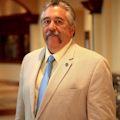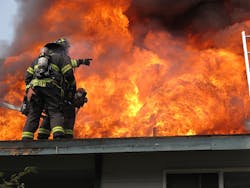Nearly every day, firefighters arrive at a house fire, apartment or high-rise fire to find individuals trapped because there weren’t working smoke alarms or fire sprinklers. In many incidents, the fire has spread from one home or building to another, causing hundreds of thousands, if not millions, of dollars in lost property.
It’s not just the occupants who are in jeopardy; the firefighters arriving to help are also in harm’s way, many giving their lives annually in the line of duty. But incidents like these don’t need to happen.
Spread the word
Few people—including lawmakers, the public and those opposed to mandating sprinklers in new construction—understand the devastation that fire can cause in a matter of minutes. The fire service has known for decades that fire sprinklers are the best way to keep the public and firefighters safe from fire. It’s an undeniable fact that’s well-documented. We now just need to spread the word.
Consider Prince George’s County, MD, one of the first jurisdictions in the country with a residential sprinkler law. Between 1992 and 2015, there were more than 20,700 reported fires in the county. Of those, there have been zero fire-related deaths and 23 fire-related injuries in homes with sprinklers, as opposed to 230 fire-related deaths and 621 fire-related injuries in homes without sprinklers. Furthermore, the average property loss in homes with sprinklers in Prince George’s County during that time was roughly $57,000 less than homes without fire sprinklers.
Fight back
Despite this evidence, the people who lobby against fire sprinklers deny the facts. They tell the public and politicians there is no such proof and falsely claim that sprinklers do more harm than good. The National Fallen Firefighters Foundation (NFFF), through our Everyone Goes Home® program, works with the American fire service and our many partners to educate the public, policymakers and the media about sprinklers.
We can see similarities in this issue to the fight against the automobile industry over airbags. During the mid-1970s, lobbyists for the automakers said airbags were unnecessary, too expensive and claimed the public didn’t want the extra cost. But technology improved, and the public’s expectations increased. Airbags went from a luxury to a standard in 1997. This happened because Americans recognized the risks they faced on the roadways. This desire to be safe required an industry shift that led automakers to advertise safety as a selling point.
Reaching out
In December 2015, the NFFF brought together fire service leaders and fire safety advocates to look for new ways to reach the public and politicians about the realities of fire. The goal for “Leading and Living Life Safety Lessons Learned” was to make advocating for policies a greater priority and develop a blueprint for addressing the issue on the local, state and national levels.
Maryland State Fire Marshal Brian Geraci emphasized education as critical for helping local and state politicians, developers, builders and the public understand why fire sprinklers are imperative. Geraci believes that hosting side-by-side burns to demonstrate how quickly fire spreads and how drastically fire dynamics have changed in modern homes is one of the most effective methods to reach all audiences.
Geraci suggested talking with real estate appraisers about offering credit for new homeowners who install fire sprinklers. Because homeowners get credit for upgraded counter tops, baths and cabinets—which are purely cosmetic—why not sprinklers?
Work together
We have the facts, the experience and hopefully the trust of the community on our side. It’s our job to make sure the public knows the truth. We must work together to ensure that jurisdictions across the country adopt resolutions requiring fire sprinklers in new homes and the retrofit of high-risk occupancies, such as bars/nightclubs, high rises, off-campus housing, boarding homes, etc. This simple measure will protect everyone.
Sidebar: Partnerships Matter
The NFFF, Phoenix Society for Burn Survivors, and Common Voices frequently partner with local fire departments and state or national fire service organizations to get the message out. A great example is the December 2014 high-rise fire in Castle Hills, TX, where six residents lost their life, 18 were injured, hundreds of people were scared, and hundreds of firefighters were placed at risk because of a lack of fire sprinklers.
The NFFF, Phoenix Society for Burn Survivors, and Common Voices joined the San Antonio Fire Department to utilize this teachable moment. We put out press releases, correspondence with local media, and spoke with local, state and federal lawmakers on the impact of those fires on peoples’ lives. We also helped them get information and resources from the NFSA about fire sprinklers.
Sidebar: Resources
Everyone Goes Home
Life Safety Initiatives + Leading and Living Life Safety Lessons Learned
In March 2004, a Firefighter Life Safety Summit was held to address the need for change within the fire service. At this summit, the 16 Firefighter Life Safety Initiatives were created and a program was born to ensure that Everyone Goes Home. LSI #15 is Code Enforcement & Sprinklers: “Advocacy must be strengthened for the enforcement of codes and the installation of home fire sprinklers.” Download Leading and Living Life Safety Lessons Learned—Myths, Misconceptions and Misinformation to learn more.
http://www.everyonegoeshome.com/wp-content/uploads/sites/2/2016/04/Life-Safety-Report.pdf
Home Fire Sprinkler Coalition
Benefits of Residential Fire Sprinklers: Prince George’s County 15-Year History with its Single-Family Residential Dwelling Fire Sprinkler Ordinance – August 2009
In 1992, Prince George’s County, MD, enacted an ordinance mandating the installation of automatic fire sprinkler systems in new one- and two-family structures. Through a partnership with the HFSC, the Maryland State Fire Marshal’s Office, the Prince George’s County Fire Department, and the University of Maryland University College, a study was conducted to review Prince George’s County’s experience with this ordinance between 1992 and 2007. The most obvious benefit of the ordinance is the direct impact that home fire sprinkler systems have made in saving lives and reducing fire-related injuries.
https://homefiresprinkler.org/wp-content/uploads/2016/05/Prince-Georges-County-Report.pdf
Executive Fire Officer Research
Residential Sprinklers: One community’s experience twelve years after mandatory implementation – January 2001
Ronald J. Siarnicki’s EFO paper reviews Prince George’s County’s experience with the introduction of residential sprinklers into the housing market and, more importantly, what results have been acquired 12 years after a mandatory ordinance was enacted.
http://pvvfd.org/fireteamusa.com/wp-content/uploads/2015/09/2001-Prince-George-County-MD-12-Year-Report.pdf
Residential Sprinklers – An Essential Part of Your PPE
This flyer is used to remind us that the time is long overdue to ensure that fire-related deaths and injuries don’t have to continue at the same rate. The current national model building and fire codes require fire sprinklers in all new residential occupancies, and states and local governments should not be weakening these codes and standards. The time is now to make fire sprinklers part of your PPE, for your career and family.
About the Author

Ronald Siarnicki
National Fallen Firefighters Foundation
Fire Chief Ronald Jon Siarnicki began his career as a firefighter with the Prince George's County Fire/EMS Department in 1978 and with 24 years of fire, rescue, and emergency medical services operational experience, he has progressed through the ranks to Chief of the Department. In this position he served as the Chief Executive Officer responsible for the fire, rescue and emergency medical services of Prince George's County, Maryland. In July of 2001, Chief Siarnicki retired from the Prince George?s County Fire/EMS Department to take the position of Executive Director of the National Fallen Firefighters Foundation in July of 2001. He is a graduate of the Masters Program, School of Management and Technology, at the University of Maryland, University College, College Park, Maryland and has a Bachelor of Science Degree in Fire Science Management from UMUC. He is a certified Fire Officer IV, Fire Fighter Level III, and State Emergency Medical Technician. He has served as a UMUC faculty member for the Fire Science Curriculum since 1997.
